Breaking records, breaking ground: The latest in European tunnelling projects
31 May 2023
Despite the challenges, tunnelling remains an essential tool for expanding infrastructure networks and connecting communities, and construction firms across the globe continue to push the boundaries of what’s possible with each new project writes Catrin Jones.
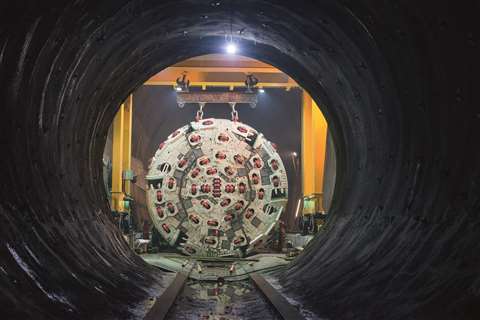 Ahrental/Pfons Exploratory tunnel – Brenner Base Tunnel (Photo: Brenner Base Tunnel/BBT-SE.com)
Ahrental/Pfons Exploratory tunnel – Brenner Base Tunnel (Photo: Brenner Base Tunnel/BBT-SE.com)
Tunnelling projects across Europe are digging deeper and becoming more ambitious each year as the demand for enhanced transportation networks increases.
Some of the world’s largest underground projects are taking place in European cities and 2023 has seen some of them reach new heights (or lows) as TBMs achieve significant tunnelling milestones.
At the end of March, the tunnelling team of HS2 in Warwickshire, UK celebrated a major breakthrough as the tunnel boring machine ‘Dorothy’ broke through the wall of the Long Itchington Wood Tunnel south portal.
TBM milestone reached
The Balfour Beatty Vinci team were present to witness the moment when the cutter head broke through the reception box headwall. This milestone marks the end of a three-year operation, which involved site set-up, TBM assembly, the first TBM drive and breakthrough, and now the completion of the second breakthrough.
The TBM was launched in November of the previous year, and it took only four months for the 2,000 tonne machine to complete its 1.6km second bore, making this the first complete twin-bore tunnel on the HS2 project.
After completing the first bore of the tunnel in July 2022, the 125m-long TBM was dismantled and returned to the north portal where it was reassembled ready to start its second journey.
Huw Merriman, the UK’s minister for transport, said, “This is yet another ground-breaking moment in delivering HS2 and transforming journeys and communities across Britain.
“With the help of TBM Dorothy, these tunnels are paving the way for HS2 trains while preserving ancient woodland on the land above. These tunnels help ensure that we deliver this transformative project while protecting the natural environment.”
The end is in sight
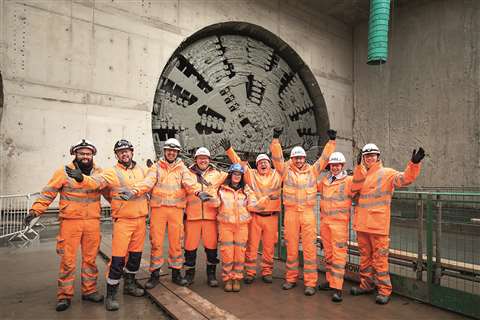 HS2 celebrates historic first tunnelling breakthrough (Photo: HS2)
HS2 celebrates historic first tunnelling breakthrough (Photo: HS2)
Positive news continues from elsewhere in the tunnelling industry as the biggest construction lot on the Brenner Base Tunnel has been announced to be 91% complete after a tunnel boring machine (TBM) ended its four-year journey at the Italian-Austrian border.
TBM Virginia has officially finished its journey at the Brenner Pass construction site in Italy. Since beginning its journey in 2019, it has been reported to have excavated 14km under the Alps, proceeding at an average daily speed of 10.2m.
The completed tunnel, the Mules 2-3 section, is being built by BTC JV comprising Ghella, Webuild and PAC. The Mules 2-3 section includes two 14km-long single-track tunnels excavated with two 10.7m-diameter TBMs, and one 14km-long exploratory tunnel excavated with a 6.85m-diameter TBM.
The Mules 2-3 section is the most challenging part of the Brenner Base Tunnel project. This is largely down to the wide variety of rock formations and an associated variety of mechanical behaviours that the tunnel route passes through.
Once completed, the 64km Brenner Base railway tunnel, commissioned by Brenner Base Tunnel Societas Europae (BBT SE), will be regarded as the longest in the world, connecting Fortezza in Italy with Innsbruck in Austria.
Meanwhile, in Scandinavia, Skanska has been awarded a NOK 5 billion (€471 million) contract by the Norwegian road authority, Statens vegvesen, to work on the northern part of the Boknafjord tunnel in western Norway.
The subsea tunnel is part of the E39 Rogfast project across Boknafjord, connecting the municipalities of Randaberg and Bokn in Rogaland County. It will replace the ferry currently used to cross the fjord and upon completion will be the world’s longest and deepest subsea road tunnel, with a length of 26.7km and a maximum depth of 392m below sea level.
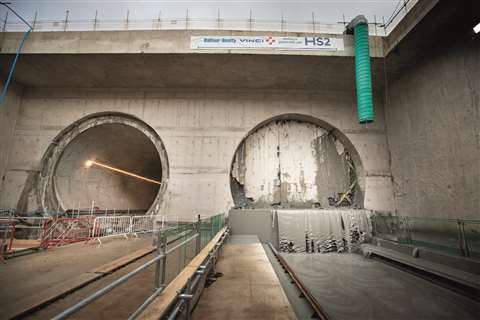 HS2’s first twin bore tunnel completion (Photo: HS2)
HS2’s first twin bore tunnel completion (Photo: HS2)
Skanska will be responsible for the E04 Boknafjord tunnel north, which is one of three key tunnelling contracts and will construct 18.5km of road in the tunnel and 2km of the road above ground.
The project’s total cost is NOK22bn (€2 billion), and the contractor is expected to have begun work on the project in the first quarter of 2023, with completion scheduled for the third quarter of 2029.
Digging deeper in tunnelling projects
It is fair to say that tunnelling projects have become more innovative over the past decade – we’re digging deeper, further, and using equipment that can pack a serious punch. A European megaproject that is hitting all three markers is the Grand Paris Express.
The France-based project is certainly ambitious and aimed at transforming Paris and its suburbs into a sustainable and interconnected metropolis. The project includes the construction of four new metro lines (15, 16, 17 and 18) and the extension of two existing lines (11 and 14). With a total investment of over €35 billion, the Grand Paris Express is currently the largest urban infrastructure project in Europe.
It is reported that up to 90% of the new lines under construction for the Grand Paris Express will be located underground, with numerous TBMs operating on the project.
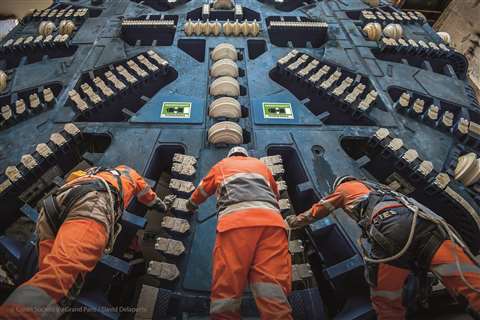 Herrenknecht TBM’s - making an impact on Grand Paris Express (Photo: Photo: Société du Grand Paris/ David Delaporte)
Herrenknecht TBM’s - making an impact on Grand Paris Express (Photo: Photo: Société du Grand Paris/ David Delaporte)
In fact, as of August 2020, the companies enlisted by Société du Grand Paris to execute the construction have procured 21 tunnel boring machines from Herrenknecht. These machines, which include 17 EPB Shields and four multi-mode TBMs, range in diameter from 7.7m to 9.8m and are specially tailored to the demands of the project. Their role is to excavate a total of around 96km of tunnel, which will then be lined with concrete segments.
The procurement of these tunnel boring machines is critical to the success of the Grand Paris Express project. The specially designed EPB Shields and multi-mode TBMs are versatile enough to operate efficiently in the various ground conditions encountered during the excavation process.
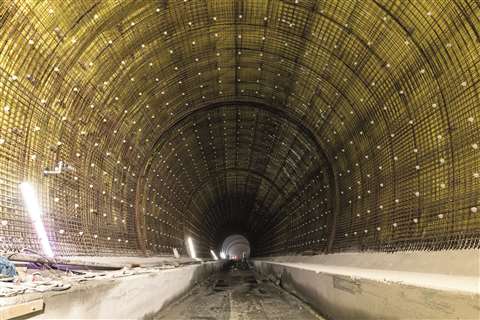 Reinforcing the inner lining of construction lot Tulfes-Pfons – Brenner Base Tunnel (Photo: Brenner Base Tunnel/BBT-SE.com)
Reinforcing the inner lining of construction lot Tulfes-Pfons – Brenner Base Tunnel (Photo: Brenner Base Tunnel/BBT-SE.com)
Innovation at the core
When Bernard Cathelain, a board member at Société du Grand Paris, spoke during the ‘Reinterpreting the Grand Paris Express from North American Perspectives’ panel discussion, he highlighted that innovation was at the core of the project.
Société du Grand Paris has seen the project as an opportunity to expand how we build modern infrastructure. Cathelain says, “The Grand Paris Express was designed and created because it is a real innovation and we decided that innovation should be implemented at every stage of the project.”
“We have launched many calls for projects,” Cathelain adds. “And with this project, we wanted to have some innovations, not only for the works, for instance, low carbon concrete, or to deal with the spoil we have.
“It’s unprecedented to have innovation. Innovation and evolution are the core system inside Grand Paris Express.”
The extensive use of tunnel boring machines to excavate and build the new rail lines is just one aspect of the project that highlights its complexity and magnitude.
As the construction phase continues and the tunnelling machines get to work, there is no doubt that the Grand Paris Express, and other European tunnelling projects, will become a model for innovative and sustainable urban transportation systems around the world.
DitchWitch introduces largest all-terrain directional drill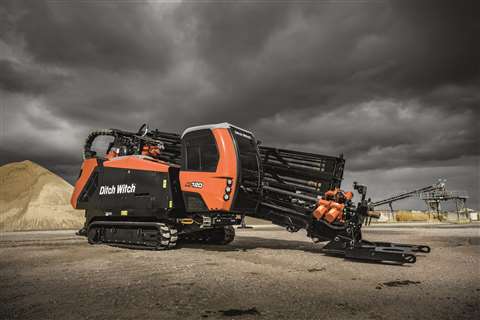
DitchWitch’s AT120 is said to give underground construction operators the power and stability needed to push through rock and tough ground conditions, streamlining fibre, pipeline and utility installation projects.
Reportedly the largest AT drill of its kind, the AT120 is said to improve jobsite efficiency for previous mid- and maxi-size drill owners, as it uses less drilling fluid, resulting in decreased jobsite waste, minimised clean-up and reduced environmental impact.
The AT120 features 15,500 foot-pounds of rotational torque and 3,000 foot-pounds of inner rotational torque. With 120,000 pounds of thrust and pullback, the AT120 allows operators to take on a wide variety of projects, as well as move through longer bores and larger diameter installations more efficiently.
The AT120 also offers users a saver lock design to protect the drill pipe and drive system against wear and tear. With an updated engine compartment and access panel design, users have increased access to critical components, streamlining maintenance routines and the serviceability of the drill.
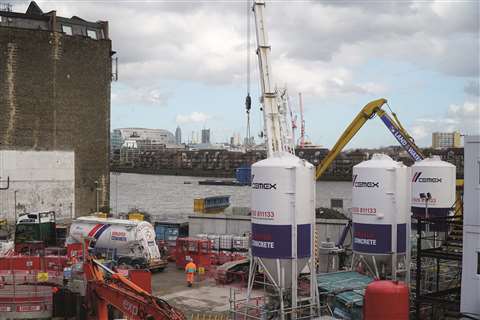
Global building materials supplier Cemex has enhanced its Vertua range of Urbanisation Solutions with a new lower carbon sprayed concrete.
The new sprayed concrete offers a sustainable enhancement to its industry renowned “Bank Mix” Silo Sprayed concrete, which has previously been utilised on UK infrastructure builds such as the Northern Line, Bank Station upgrade, London Power Tunnels 2, Thames Tideway and many others.
Michael May, sales manager for Cemex Mortars Europe, commented, “We believe the launch of this lower carbon sprayed concrete product, available now, will be valued by our customers working on significant infrastructure projects, where the use of more sustainable products is becoming increasingly important and even specified as a requirement in project tenders.
“Our previous sprayed concrete was regarded by our customers as incredibly reliable and high performing so to significantly reduce its carbon content by 23% as a first step whilst maintaining its high performance is something we are very proud of. However, we will not stand still; this new launch is just the latest stage in our roadmap to further large-scale carbon reductions.”







